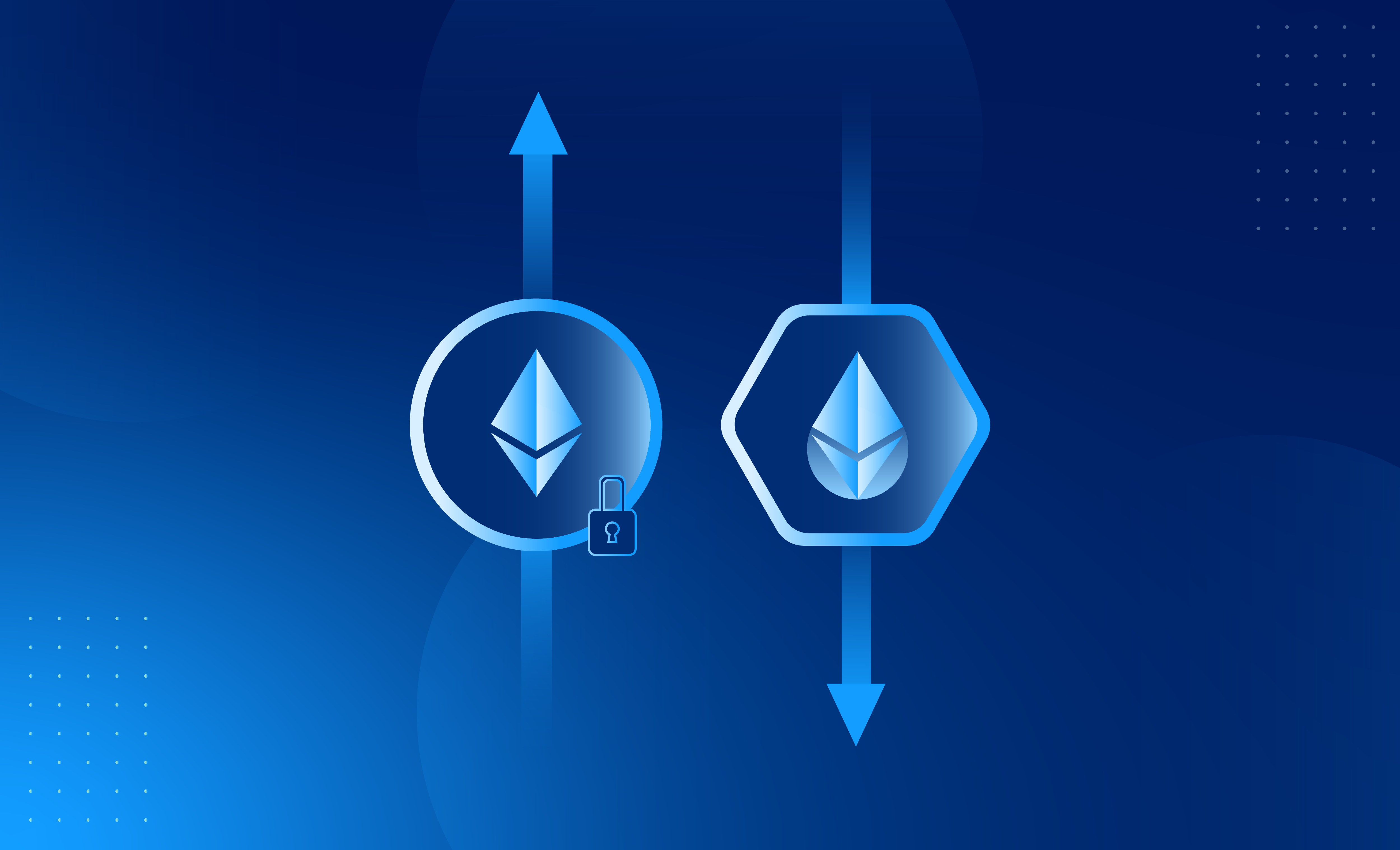Liquid Staking Derivatives is currently an important segment, with TVL ranked 1st in the DeFi market. Thanks to Liquid Staking Token, LSD has an abundant source of liquidity. So what is Liquid Staking Token? Let’s learn about this interesting topic with Coincu.
But first, let’s understand what the concept of Liquid Staking is.
What is Liquid Staking?
Liquid Staking, a novel concept gaining momentum, allows users to access liquidity while actively participating in staking tokens. The essence of Liquid Staking lies in the protocols that enable users to stake a particular asset.
A 1:1 Ratio for Liquidity and Participation
In return, these protocols issue a corresponding token, mirroring the staked asset at a 1:1 ratio. This innovative approach ensures that users can engage in blockchain ecosystems utilizing Proof of Stake (PoS) consensus mechanisms, akin to traditional staking methods.
The genesis of Liquid Staking can be traced to the surge in popularity of platform blockchains employing PoS or similar consensus mechanisms. Notably, Ethereum’s pioneering vision of Ethereum 2.0, incorporating PoS and Sharding, set the stage for subsequent platform blockchains to embrace PoS or its variations.
Use representative tokens
Unlike conventional staking models constrained by fixed stake times, Liquid Staking introduces a revolutionary concept. Instead of waiting for a predetermined period, users receive a “bill” representing their staked amount in the form of a unique token—a token symbolizing the stake collateral.
What sets this apart is the ability to utilize these tokens in various Decentralized Finance (DeFi) protocols, thereby generating additional profits. Effectively, Liquid Staking transforms the staking process into a dynamic experience, akin to storing funds in a DeFi escrow account.
Born because of the liquidity of DeFi
The protocol’s liquid and flexible nature distinguishes it in the blockchain sphere, providing users with the freedom to access their funds during the staking period. This newfound liquidity not only enhances the user experience but also opens doors to innovative possibilities within the rapidly evolving DeFi landscape.
Liquid Staking Derivatives
Overview
The Liquid Staking Derivatives protocol is a transformative solution, enabling users to leverage blockchain coins for the creation of synthetic assets. This innovative protocol not only represents the quantity and value of staked coins on Proof of Stake blockchains but also introduces a novel array in the derivatives market.
At their core, Liquid Staking Derivatives empower investors to engage in trading activities involving multiple products, all based on price movements, without the necessity of owning the underlying assets. This versatility opens up new avenues for investors looking to diversify their portfolios and capitalize on market fluctuations.
Benefits of Liquid Staking Derivatives
The Liquid Staking Derivatives Protocol presents users with a dual-income stream, allowing them to earn enhanced profits from both block rewards and incentives offered by DeFi protocols.
This innovative approach not only boosts individual earnings but also contributes to the overall efficiency of capital utilization within the network.
As users actively stake tokens within the Liquid Staking Derivatives protocol, they inadvertently contribute to the broader blockchain network. This influx of participants enhances network security and fosters greater decentralization.
The collective involvement of users fortifies the underlying infrastructure, ensuring a more resilient and distributed network.
Node operators play a crucial role in the protocol’s functionality, supporting stakers by managing hardware and software for effective coin staking. In return, they receive a portion of the fees generated, incentivizing their commitment to maintaining the network’s integrity and operational efficiency.
Projects integrated with the Liquid Staking Derivatives Protocol witness a surge in Total Value Locked (TVL) and trading volume. Users utilizing tokens from this protocol contribute to the growth of projects on the network, amplifying their visibility and economic activity.
Token holders within the Liquid Staking Derivatives projects enjoy a share of the generated revenue and actively participate in the governance of the project. This inclusive model ensures that stakeholders have a voice in decision-making processes, fostering a sense of community and shared ownership.
About Liquid Staking Token (LST)
In the rapidly evolving landscape of DeFi, the concept of staking has gained significant traction, allowing users to actively participate in network operations by locking up tokens. However, a groundbreaking development known as Liquid Staking Tokens (LST) is reshaping the staking landscape, providing a novel solution to the liquidity challenge associated with traditional staking mechanisms.
The birth of Liquid Staking Token
Staking, in its conventional form, requires users to lock up a specified number of tokens to support network operations, such as transaction validation or consensus mechanisms like Proof-of-Stake. Once tokens are staked, they typically become illiquid, restricting their easy accessibility or sale. This is where Liquid Staking Token comes into play, introducing a transformative approach to staking protocols.
In essence, Liquid Staking mirrors traditional Proof-of-Stake protocols, with users depositing funds directly into the protocol’s smart contracts. In return, the platform issues Liquid Staking Tokens at a 1:1 ratio, representing the staked assets. These tokens act as blockchain receipts, serving as tangible proof of ownership for the staked digital assets.
What is Liquid Staking Token?
A Liquid Staking Token serves as a tokenized representation of the staked assets, allowing users to retain flexibility and tradeability. When a user stakes their assets, they receive an equivalent amount of Liquid Staking Tokens.
The versatility of Liquid Staking Tokens within the DeFi ecosystem is noteworthy. Similar to other blockchain assets, these tokens can be employed for various purposes, amplifying their utility and further integrating staked assets into the broader decentralized financial landscape.
Different from traditional tokens
Unlike traditional staked assets, these tokens can be freely traded, sold, or utilized in other DeFi protocols, providing liquidity to stakers even as their original assets remain staked.
To illustrate, if a user stakes 1 ETH into a Liquid staking protocol, they are issued one stETH in return, with “stETH” operating as the protocol’s native token representing the staked ETH.
How Liquid Staking Token Works
The way Liquid Staking Tokens work is closely tied to the Liquid Staking Platforms, so to understand how Liquid Staking Tokens work, we should also learn how Liquid Staking Platforms work.
How Liquid Staking Platforms Work
The operating mechanism of these platforms unfolds in a strategic sequence, offering users a unique opportunity to maximize their returns while participating in various DeFi activities.
Users initiate the process by depositing their assets into the platform, with a primary focus on platform coins like NEAR, SOL, FTM, AVAX, and ETH.
The platform employs validator partners to deposit user assets into validators, creating a mechanism to generate profits from staking activities.
Simultaneously, the protocol issues derivative assets back to the users. These derivatives, such as stNEAR, sNEAR, stSOL, mSOL, stETH, dETH, vary across different platforms. Each derivative asset holds a value equivalent to the original asset deposited by the user.
Users armed with these derivative assets actively engage in a myriad of DeFi activities, including Automated Market Making (AMM), Lending & Borrowing, Derivatives trading, and Yield Farming. The versatility of these assets opens doors to a wide range of DeFi protocols that readily accept them.
To reclaim their original assets, users can simply send the derivative asset back to the platform, initiating a burn process. In return, the platform efficiently returns the equivalent original asset to the user, completing the seamless cycle.
Liquid Staking Token Participates in The Mechanism
Redeem platform assets
Leading platforms such as Lido Finance and Rocket Pool allow users to deposit Ether into staking pools and receive Liquid Staking Token representing their holdings and accrued interest.
The Liquid Staking Token, exemplified by Lido’s stETH and Rocket Pool’s rETH, empowers users to seamlessly navigate the DeFi space. By utilizing LSTs, individuals not only maintain control over their capital but also enjoy the benefits of yield generation.
Liquid Staking Token Finance is created
Taking this a step further, Liquid Staking Token Finance (LSTFi) protocols have entered the scene, introducing novel ways to enhance capital efficiency. These platforms provide users with opportunities to actively engage their ETH and Liquid Staking Token, maximizing their potential returns.
Implement staking strategies
LSTFi protocols leverage innovative mechanics to boost yield by strategically deploying staked assets across various DeFi protocols. This approach enables users to compound their staked ETH, creating a dynamic ecosystem where capital works efficiently to generate optimal returns.
The capital efficiency introduced by LSTFi projects marks a significant advancement in the DeFi space, allowing users to unlock the full potential of their assets.
Advantages of Liquid Staking Token
Here’s a closer look at the distinct advantages that Liquid Staking Token brings:
Increased Capital Efficiency
One of the standout advantages of Liquid Staking Tokens is the enhanced capital efficiency they provide. Users can now maximize the utility of their staked assets by seamlessly earning staking rewards while actively participating in various DeFi activities. This simultaneous engagement allows for a more dynamic and efficient use of capital.
Flexibility at its Core
Liquid Staking Tokens introduce a level of flexibility that distinguishes them from conventional staking protocols. Unlike traditional staking, which often involves extended “unbonding” periods, Liquid Staking enables users to exit positions or engage with the market promptly.
The key distinction lies in the fact that, with Liquid Staking, users’ assets are not entirely locked; instead, protocols issue representative assets at a 1:1 ratio.
Diversification Strategies
Users now have the ability to diversify their staking strategies by participating on one platform while utilizing Liquid Staking Tokens to engage with another. This flexibility allows for a more strategic and diversified approach to DeFi activities, aligning with the ever-changing dynamics of the market.
Bringing Liquidity to Staking Assets
A primary objective behind the development of Liquid Staking Tokens is addressing the liquidity challenge associated with traditional staking. Through the use of representative tokens, users can leverage their staked assets to earn additional yield via lending or trading on various DeFi protocols. This not only boosts capital efficiency but also opens up new avenues for yield generation.
Risk Mitigation in Validator Issues
Liquid Staking introduces a technical advantage by reducing the risk associated with direct staking. In conventional staking, token owners delegate their assets to a single validator, exposing them to the risk of loss if the validator takes detrimental actions.
However, Liquid Staking Tokens are delegated to multiple validators, significantly lowering the risk of asset loss. Moreover, Liquid staking protocols often incorporate insurance funds to provide an added layer of security, compensating users in the event of unforeseen issues.
Disadvantages of Liquid Staking Token
Complexity in DeFi Landscape
The integration of LSTs introduces an additional layer of complexity to the already intricate DeFi ecosystem. Navigating through the various protocols and mechanisms associated with Liquid Staking adds a level of intricacy that users and protocols need to consider.
Over-Collateralization Concerns
Some protocols may impose higher collateral requirements for LSTs compared to more traditional assets, potentially making them less capital-efficient. This over-collateralization can impact the overall effectiveness of utilizing Liquid Staking Tokens within DeFi systems.
Price Discrepancy and Arbitrage Opportunities
The value of LSTs may not always align with the underlying staked assets, leading to potential price discrepancies and creating arbitrage opportunities. This discrepancy raises concerns about the accurate representation of value within the DeFi space.
Risk for Lending Protocols and Users
Liquid Staking Derivatives pose different risks for lending protocols and users. While lending protocols may face challenges related to bad debt, users who stake tokens like stETH, rETH, and ankrETH bear risks associated with low liquidity. Large sell-offs within a short period could result in de-pegging of these tokens.
Chain Risks in DeFi Operations
The utilization of Liquid Staking Derivatives tokens elsewhere in DeFi introduces chain risks. For instance, mortgaging stETH on platforms like Aave to borrow other assets could expose users and lending protocols to risks. If the value of stETH experiences a sudden drop, loan positions become precarious, leading to potential bad debt scenarios.
Exploitation of Contract Vulnerabilities
The DeFi space has witnessed instances where hackers exploited smart contract vulnerabilities in projects like Stader Labs or Acala. This led to the unauthorized minting of derivative tokens, which were then liquidated on decentralized exchanges to collect native tokens. Such incidents highlight the importance of addressing and securing against potential vulnerabilities in smart contracts associated with Liquid Staking.
Development trend of Liquid Staking Token
The number of holders is increasing
The inherent interoperability of Liquid Staking Token is a key factor contributing to their appeal. These tokens boast versatility, enabling their utilization across a spectrum of DeFi platforms. This interoperability fosters increased integration and harmony within the broader DeFi ecosystem, creating a more interconnected and efficient environment.
Beyond liquidity, Liquid Staking Token plays a crucial role in yield farming. Holders of LSTs gain access to a spectrum of DeFi strategies, including yield farming, presenting an enticing opportunity to amplify returns. This feature adds a layer of profitability for users who choose to engage in various DeFi activities while holding LSTs.
Grow with Liquid Staking
Moreover, the utility of Liquid Staking Token extends to their function as collateral. These tokens can be readily employed as collateral in numerous lending and borrowing protocols, providing users with an elevated degree of financial adaptability. It can be said that the trend of Liquid Staking and Liquid Staking Token will continue to grow in the future as DeFi grows stronger.
Conclusion
Unlike conventional staking, where assets are often locked for a predetermined period, Liquid Staking Token enables users to retain liquidity while participating in staking activities. This flexibility has contributed to their popularity, attracting a diverse range of users eager to engage with the burgeoning DeFi ecosystem.
Despite their apparent stability, recent market dynamics have revealed a vulnerability in the value of Liquid Staking Token. During liquidity crunches or when unexpected events transpire, these tokens can experience a drop below the price of the underlying asset. Looking ahead, the trajectory of Liquid Staking and its associated tokens will likely hinge on the stabilization of user numbers within the DeFi space.
DISCLAIMER: The information on this website is provided as general market commentary and does not constitute investment advice. We encourage you to do your own research before investing.




















